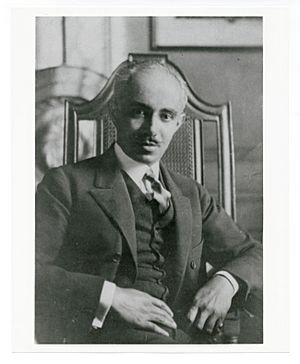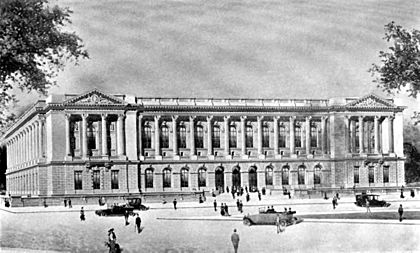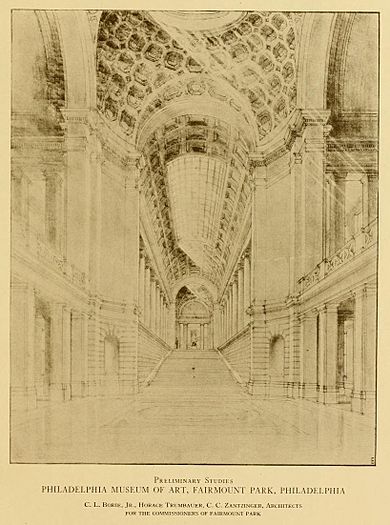Julian Abele facts for kids
Quick facts for kids
Julian F. Abele
|
|
|---|---|

Julian Abele (photo Duke University Archives)
|
|
| Born |
Julian Francis Abele
April 30, 1881 Philadelphia, Pennsylvania, U.S.
|
| Died | April 23, 1950 (aged 68) Philadelphia, Pennsylvania, U.S.
|
| Alma mater | Cheyney University (1896) Pennsylvania Museum School of Industrial Art (PMSIA) (1898) University of Pennsylvania, (B.A., Architecture, 1902) |
| Occupation | architect |
|
Notable work
|
Duke University Campus Duke University Chapel Cameron Indoor Stadium Allen Administrative Building (completed after his death) |
| Spouse(s) | Marguerite Bulle (m.1925) |
| Children | 3 |
| Relatives | Absalom Jones (Episcopal priest) Julian Abele Cook Jr. (judge) |
Julian Francis Abele (born April 30, 1881 – died April 23, 1950) was an important Black American architect. He was the main designer for the Horace Trumbauer architecture firm. Abele helped design over 400 buildings. These include famous places like the Widener Memorial Library at Harvard University and the Philadelphia Museum of Art. He also played a key role in designing the west campus of Duke University.
Even though he designed many buildings, Julian Abele only publicly took credit for the Duke University Chapel during Horace Trumbauer's lifetime. After Trumbauer passed away in 1938, Abele became a co-leader of the firm. He then designed more buildings at Duke, such as the Allen Administrative Building and Cameron Indoor Stadium.
Contents
Julian Abele's Early Life and Family
Julian Abele was born in Philadelphia into a well-known family. His family had a history of community involvement. His grandfather, Robert Jones, started the Lombard Street Central Presbyterian Church in the late 1700s. Abele was also related to Absalom Jones. Absalom Jones founded the first Black church in Philadelphia in 1794.
Julian Abele was very artistic and worked with many materials. He used watercolor, lithography, and etching. He also designed and built all his own furniture. He even did the detailed needlework called petit point himself. He knew many old building styles, but he especially loved the Louis XIV French style.
Julian Abele's Education Journey

Abele went to the Quaker-run Institute for Colored Youth. This school later became Cheyney University. He was very good at math there. He was even chosen to give the graduation speech. In 1898, he finished a two-year course in architectural drawing. This was at the Pennsylvania Museum School of Industrial Art.
He made history as the first Black student accepted into the architecture program at the University of Pennsylvania. This was a big achievement because Black students faced many challenges. For example, they could not live in dorms or eat in the school cafeteria. For group projects, he worked with Louis Magaziner. Louis was the only Jewish student and also faced unfair treatment. They became lifelong friends.
In 1901, Abele won a student competition. He designed a special entrance for walkers. His design was a curved bench with steps in the middle. This design became his first real project. It was built at Haverford College. Today, it is called the Edward B. Conklin Memorial Gate. His classmates respected him and called him "Willing and Able." He also won awards for his designs of a post office and a botany museum. He was even elected president of the university's Architectural Society.
He graduated from the University of Pennsylvania in 1902. He was the first Black graduate from their architecture department. After graduating, he worked part-time for an architect. He also took evening classes at the Pennsylvania Academy of the Fine Arts. A Philadelphia architect named Horace Trumbauer helped him financially. This allowed Abele to travel through France and Italy. This trip greatly influenced his designs for the rest of his life.
Studying Architecture in Europe
Between 1903 and 1906, Julian Abele traveled across Europe. His family believes he studied at the famous École des Beaux-Arts in Paris. However, records do not clearly show his enrollment there. He might have attended classes informally. When he applied to the American Institute of Architects, he listed travel to many European countries. He did not specifically mention studying at the École des Beaux-Arts.
Julian Abele's Career Highlights
After graduating in 1902, Abele went to Spokane, Washington. There, he designed a house for his sister, Elizabeth Abele Cook. Then he returned to the East Coast. In 1906, Abele joined the Trumbauer firm. He started as an assistant to the chief designer, Frank Seeburger. When Seeburger left in 1909, Abele became the chief designer. Everyone at the firm knew how important Abele was. He was the second-highest paid employee.
Art historian David B. Brownlee studied the design of the Philadelphia Museum of Art. This project took 14 years, from 1914 to 1928. Brownlee credits another architect, Howell Lewis Shay, for the building's overall layout. However, the final detailed drawings were clearly done by Abele. Abele also designed the famous outdoor steps and terraces. These steps are well-known from the 1976 film Rocky.
After Horace Trumbauer died in 1938, the firm continued. It was called "Office of Horace Trumbauer." Abele and William O. Frank were the co-leaders. It was a tough time to get new projects because of The Depression and World War II. Still, the firm completed the Duke Indoor Stadium at Duke University in 1940. This stadium was renamed Cameron Indoor Stadium in 1972. They also added to Duke's Library in 1948. And they designed Duke's Allen Administrative Building, which was finished in 1954.
When Abele joined the American Institute of Architects in 1942, he was highly praised. The director of the Philadelphia Museum of Art, Fiske Kimball, called him "one of the most sensitive designers in America." Smithsonian Magazine later described him as "probably the most accomplished [Black architect] of his era."
Despite designing much of Duke University, Abele faced challenges. He was refused a hotel room in Durham during a visit to the campus. It wasn't until 1988 that his portrait was displayed at the University. Today, the main quad at Duke University is named Abele Quad. A special plaque honors his contributions in a busy spot on campus.
Julian Abele's Personal Life
In 1925, when he was 44, Julian Abele married Marguerite Bulle. She was a French pianist. They had three children: Julian Abele, Jr., Marguerite Marie Abele (who died young), and Nadia Boulanger Abele. Marguerite left him in 1936. She later had three more children with another man.
Julian Abele passed away from a heart attack in 1950 in Philadelphia. He is buried at Eden Cemetery in Collingdale, Pennsylvania.
Julian Abele's Legacy
- The Allen Administration Building at Duke University, which he designed, was finished after he died in 1950.
- In 1988, Duke University honored Abele. They displayed his portrait in the main lobby of the Allen Building. This was the first portrait of an African-American on the campus. To recognize his important work on Duke University's West Campus, the main quad is now officially named Abele Quad. A dedication plaque is placed right in the center of the campus.
- On August 17, 2012, construction began on Julian Abele Park. This park is located at 22nd & Carpenter Streets in Philadelphia.
- Architectural historian Dreck Spurlock Wilson is writing the first biography about Julian Abele.
Images for kids
-
Duke University Chapel, Durham, NC (1932).
See also








